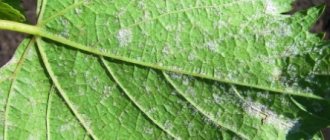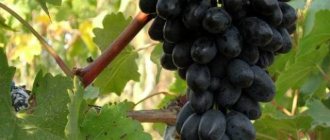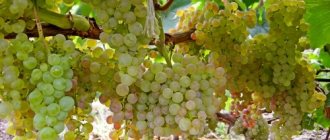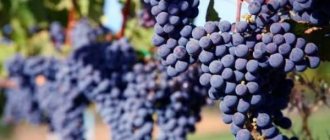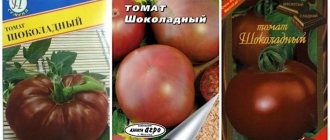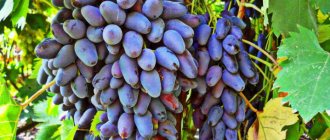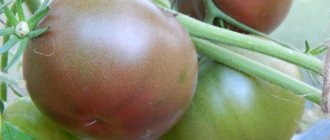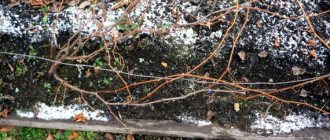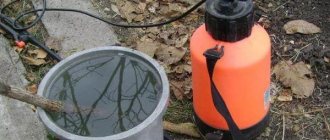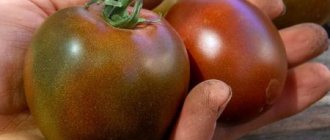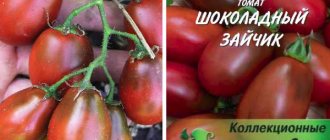In most cases, grapes are grown for fresh consumption. Various varieties are grown and sent to other cities. But not all varieties have the possibility of long-term storage. For transportation over long distances, a type of grape was bred - Chocolate.
In addition to good preservation, the variety has increased disease resistance and high yield. In order to plant it on your own plot, you need to prepare in advance and know the nuances of planting and preparing a seedling.
Description of the Chocolate grape variety (Maradona)
Resistant to diseases, the fruits do not crack and can remain on the bush until frost without harm to the crop, and their color becomes deeper and more saturated. Maradona (Chocolate) grapes are an excellent table variety, are perfectly stored, without losing either taste or marketability kind. It can be safely grown for sale, since the berries easily tolerate transportation even over long distances. The growing season for this variety lasts from 135 to 150 days.
Attention! Maradona grapes ripen fully at the end of September or mid-October. This is an excellent indicator, because during this period all table varieties have long been collected, only technical varieties remain.
The leaves of the Maradona grape are five-fingered, dissected, with a glossy surface. The clusters are voluminous (weighing up to 1.5 kg or more), cone-shaped, and have wings. The berries are oval, slightly elongated, the skin is thin, but not prone to cracking. The weight of each can reach 10 g. The flowers are bisexual. This means that the variety is self-pollinating.
Main characteristics
The “chocolate” variety refers to the table grape variety. It is also worth noting such table varieties as “ruta”, “Dubovsky pink” and “valek”.
Maturation
In terms of ripening time, the variety is considered medium and medium-late (130-145 days).
Fruiting (called maturity) is extended - from August 20-25 to September inclusive (depending on the growing region), in some places it is possible until October frosts.
Bush
It is strong in growth, the shoots ripen well, their length can reach up to 15 m, the petioles also take root well.
Reference! It is recommended to form the bush using a standard form.
bunches
The brush is attached with a long stem to the vine shoot:
- The size is large and very large.
- Weight from 600 to 800 g, individual brushes up to 2.5 kg.
- They have medium density.
- Drop-shaped, possibly with a wing.
Berries and taste
The berries have a very sweet, refreshing, pleasant and harmonious chocolate flavor. Depending on growing conditions, they may differ in shape from elongated to oval. Main characteristics:
- The size is large (23 x 31 mm).
- Weight – 8g to 10g.
- Sugar -18%.
- Acidity -5-6 g/l.
- Easily detachable bone - 1-3 pcs.
- Color ranges from red-brown to chocolate.
- The skin is thin and durable.
- The pulp is elastic, fleshy, juicy.
Pros and cons of the Maradona (Chocolate) grape variety
Growing any grape has its pros and cons.
The advantages of Maradona include:
- good rates of rooting and growth of the vine;
- frost resistance (withstands temperatures down to -25 °C);
- stable yield;
- the fruits do not absorb excess moisture, which means their skin does not burst.
Among the disadvantages of Maradona grapes are:
- the need for shelter for the winter, especially if the soil is sandy;
- during cloudy and rainy summers, the fruits do not acquire enough sugar and remain unripe;
- can be stored fresh for only a few months;
- The bunches need to be protected from birds; they peck them with pleasure.
Comparison with analogues
Let’s compare “chocolate” with the main varieties similar to it.
| Sign | Variety | |||
| Chocolate | Lowland | Gorgeous | In memory of the teacher | |
| Ripening period | 130-140 days | 120-130 days | 100 – 110 days | 100 -110 days |
| Frost resistance | Up to -23 °C | Up to -23 °C | Up to -25 °C | Up to -23 °C |
| Yield per bush | 10-15 kg | 6 kg | Up to 10 kg | 10 – 20 kg |
| Bunches | 600-800 g | 700 g | 400 g – 1 kg | 600 g – 2.5 kg |
| Taste | Harmonious, with chocolate flavor | Harmonious and rich, sweet with a slight sourness | Muscat with vanilla | Harmonious with notes of nutmeg |
| Color | Red-brown | Red or pink purple | Gradient from pink to purple | Pink cherry |
| Disease resistance | High | High | Average | Average |
| Shelf life | Several months | Till December | 1 – 2 months | 3 months |
| Sugar content | 16-18% | 17-18% | 18 – 20% | 18 – 20% |
| Acidity | 5-6 g/l | 8-9 g/l | 6 g/l | 6 – 8 g/l |
Reference! The name of the variety “chocolate” among fans has other names: “Maradona red”, “Taifi”.
Planting and caring for Maradona grapes (Chocolate)
Growing Maradona grapes is similar to other varieties. But there are a few things to take into account. For example, the bush of a plant is quite straggly. This must be taken into account before landing. Regarding care, the chocolate grape variety is unpretentious. And growing the crop does not require much work.
Selection and preparation of a landing site
According to the description of the Chocolate grape variety, the best places for its cultivation are slopes with black soil, loam and sandy loam soils. It is worth checking their acidity levels first (pH in the range of 5.5-6.5). Too acidic and saline soils will inhibit the growth and development of the vine. Low levels of nutrients will also not benefit Maradona (Chocolate) grapes. Rooting will take much longer, and the fruits will be tasteless and small.
When the site has been selected, it’s time to take care of preparing the land. It is better to leave all these actions for the fall. This will provide enough time for the soil to absorb all the fertilizers and also give the necessary shrinkage. When digging a trench for planting Maradona (Chocolate) grapes, certain conditions must be met, especially if there are several cuttings. Its width is 1 m, and its depth is about four bayonets of a shovel.
It is necessary to dig, moving from the north side to the south. The next step is adding fertilizers (per 1 m2 of area approximately 10 kg of humus + 60 g of nitroammophoska). Everything must be thoroughly mixed. Next comes a layer of coarse crushed stone, as well as garden soil (a layer of about 30 cm). Then the cycle is repeated, but without crushed stone. The compacted trench is left until spring.
Landing rules
Important! Maradona (Chocolate) grape seedlings should be purchased only from trusted nurseries so that they are healthy and fully comply with the standards of the declared variety.
When harvesting cuttings of Maradona (Chocolate) grapes at home, they are cut in the fall, kept in a solution of potassium permanganate, and the open sections are covered with paraffin (it will become a protective barrier against pathogens). After this, the planting material is stored in the cold (at a maximum temperature of + 2 ° C) for hardening. Planting Maradona (Chocolate) grapes in open ground is possible only if the weather is smooth and warm (+ 20-25 °C).
Additionally, you will need to follow a number of simple rules:
- Dig a hole 1 m deep. Install a special tube in the corner. It will be needed for ventilation and internal watering. Cover the bottom with a layer of fertile soil, and install the cutting on it.
- In the case of seedlings, the progress of work is somewhat different. Instances with an open root system are first thoroughly inspected for rot and damage, which are immediately removed. The cut areas are treated with wood ash or crushed activated carbon tablets.
- You need to pour a mound of earth into the hole. A seedling is installed on it. The roots should be neatly straightened. Afterwards, everything is evenly sprinkled with earth, without voids. If the seedling is initially without roots, then only one of the buds remains on the surface, the rest are rooted in the ground. If the rooting process is successful, fertile soil is poured on top and compacted well. The top of the soil is mulched and watered.
Watering and fertilizing
The roots of the Maradona (Chocolate) grape vine should absolutely not be flooded. The frequency of watering depends on the condition of the earthen clod and the weather. In one season, it is imperative to moisten the soil at least four times: before flowering, during fruit ripening, after harvesting and before sheltering for the winter. To prevent the surface of the earth from becoming a hard crust, it is loosened after each watering.
Fertilizing has a beneficial effect on the development of bushes, the taste of berries, as well as on harvest volumes. Chocolate grapes are very responsive to organic fertilizers. Compost, chicken manure, humus, and manure are usually used. Fertilizers are applied as soon as the grapes begin to bloom, during the ripening of the bunches and before the winter dormancy period. Potassium fertilizers are best suited for the final feeding; they will strengthen the plants before frost.
A slurry is made from manure, and an aqueous solution is made from litter. Dry compost is used as mulch (no more than 10 cm thick). It is also good to apply mineral fertilizers (superphosphate, saltpeter or potassium chloride). Fertilizing is usually combined with watering or spraying with antifungal drugs.
Trimming and shaping
One of the distinctive features of the Chocolate grape is the rapid growth of the bush. Every autumn the vines are pruned. There should be at least 45 eyes on an adult bush, and no more than 8 on the lashes.
There are many descriptions with photos of the molding of Chocolate grapes. The simplest one is a fan. In large areas it is convenient to form the so-called two shoulders. To decorate the yard, it is better to make an arch and send shoots along it so that they completely intertwine the structure. Autumn pruning of Maradona (Chocolate) grapes performs sanitary functions, and spring pruning gives the bush the desired shape and stimulates abundant fruiting.
Preparing for winter
In the southern regions, additional insulation is not required for Maradona (Chocolate) grapes. This is only relevant for the central and northern regions. In areas with warm winters, standard grapes are left on supports. In more severe conditions, the vines are removed and tied with ropes. A shelter is made of straw or spruce branches on the ground. A vine is placed on it, and the top is insulated using non-woven fabric or agrofibre. You can also weave special mats from reed stems.
Advantages and disadvantages
A relatively young specimen of grapes can boast a lot of advantages, although there are also some minor disadvantages. The following positive aspects are highlighted when growing Chocolate grape seedlings:
- The shrub is characterized by an increased growth rate of the vine. At the same time, the elongated young shoots have time to ripen well during the growing season. The length of such annual shoots can be up to 15 m on average. Rooted shoots take root well and quickly, which allows you to quickly obtain an original specimen.
- In rainy weather it does not absorb additional moisture, so the berries do not burst.
- It can hang on a bush for quite a long time without deteriorating or rotting.
- The plant has a fairly high resistance to frost. Without shelter, grapes can withstand temperatures down to -22..-250C. At elevated sub-zero temperatures, it is recommended to pre-prepare the shrub for winter. Otherwise, there is a possibility of the root system freezing, which will lead to the death of the plant.
- In most cases, the grape variety is not affected by fungal diseases, the variety is not susceptible to rot, and the plant has a slightly less chance of refraining from oidium or mildew. But judging by the reviews of gardeners, the grape variety does not suffer from frequent diseases. Therefore, you can safely plant it on your own plot.
- Chocolate grapes have a distinctive feature - they are perfectly preserved when transported over long distances and are stored for a long time after harvesting.
The only drawback that the plant has is that when the bunches are collected, its shelf life ends after exactly 2 months. After this period, the bubbies begin to quickly deteriorate. Therefore, it is recommended to prepare grapes in such a way as to have time to eat them or use them for other situations during the specified period.
Diseases and pests
With proper care, there are no special problems with diseases and pests. But, according to the observations of experts, most often Maradona (Chocolate) grapes are affected by various rots (downy mildew, mildew). At first, the leaves become covered with transparent yellowish spots, and then a fluffy white coating forms. If the situation cannot be dealt with in any way, the disease will spread to the stems and fruits. The most effective control measures are compliance with all watering requirements, as well as prevention. Spraying with fungicides helps (this is done before and after flowering). Preparations containing copper are especially effective.
Pests such as:
- spider mite;
- aphid;
- phylloxera;
- thrips.
You can delete them manually. Both natural and purchased products are suitable for fighting insects.
Reviews of Maradona grapes (Chocolate)
Igor Nikolaevich Shapiro, 40 years old, Berdyansk
Grapes have been my hobby for many years. I tried different varieties. I once read about Chocolate in a magazine. I decided to plant it. And I didn’t regret it. The taste is really unusual and stores well. No diseases or pests were noticed.
Evgenia Vasilievna Netrebko, 35 years old, Mukachevo
I was born and raised in the south, so it’s hard to surprise me with grapes. Friends gave me a seedling of the Chocolate variety. I made inquiries about him. At first I was a little confused by the color of the berries, but I still planted it in the yard. It has been growing for about six years without problems. The bush not only pleases the eye, but also produces a good harvest. We made homemade wine from it several times. Everyone really liked it.
Yaroslav Maksimovich Boyko, 42 years old, Mirgorod
Maradona (Chocolate) grapes are a wonderful variety. The clusters are quite large, there are no problems with diseases and wintering. Highly recommend.
History of the variety's creation
The Maradona grape was bred by the famous Soviet breeder Pavel Yakovlevich Golodriga in 1981. The variety was obtained as a result of a long selection of descendants of two parent varieties - “Katta Kurgan Kirovabad Table” and “Antey Magarachsky”. In addition to the name "Maradona", it is found under the names "Chocolate", "In Memory of Golodriga", "Taifi Sustainable", "Pavel Golodriga - 12" ("PG-12") and "Maradona Red".
In 1986, the variety entered state trials in Russia and Ukraine. Now “Chocolate” can be found in the southern regions of the Russian Federation, as well as throughout Ukraine and Moldova. Moreover, it equally attracts both owners of small personal vineyards and large farm grape complexes.
